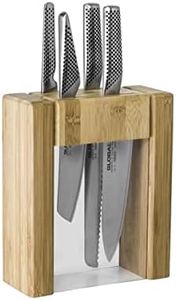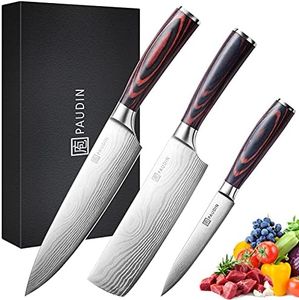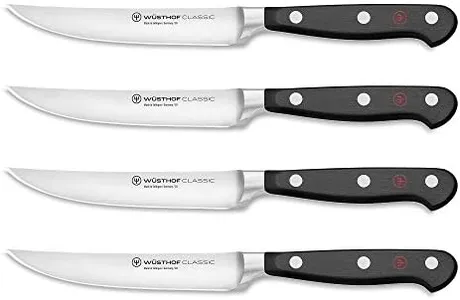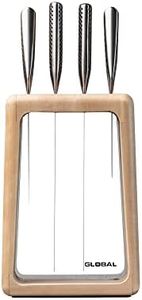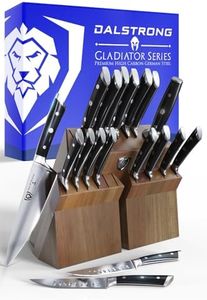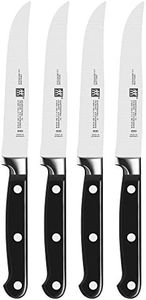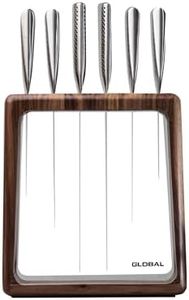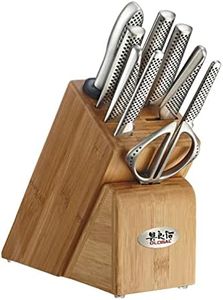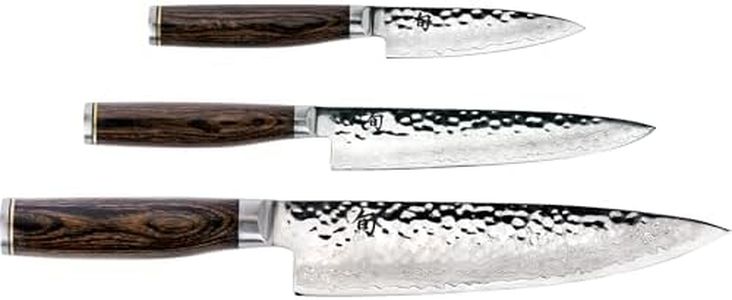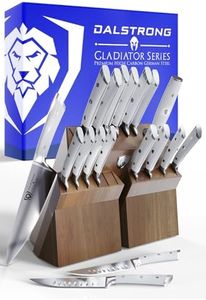We Use CookiesWe use cookies to enhance the security, performance,
functionality and for analytical and promotional activities. By continuing to browse this site you
are agreeing to our privacy policy
10 Best Professional Knife Sets
From leading brands and best sellers available on the web.Buying Guide for the Best Professional Knife Sets
When choosing a professional knife set, it's essential to think about how you'll use the knives and what tasks you'll need them for most often. A quality set should provide comfort, durability, and all the essential blades you require in the kitchen. Rather than focusing only on appearance or brand names, look at the practical features and how they fit your cooking style, hand size, and maintenance preferences. The right knife set can make food preparation more efficient, comfortable, and even enjoyable.Blade MaterialThe blade material refers to what the knife is made from—most commonly stainless steel, high-carbon steel, or sometimes ceramic. This matters because it affects how sharp the knife stays, how easy it is to sharpen, and how resistant it is to rust and stains. Stainless steel is rust-resistant and low maintenance, making it a popular choice for most people. High-carbon steel can hold a sharper edge longer but might require more care to prevent rust. Ceramic is ultra-sharp but can be brittle. Think about whether you want easy care (stainless), professional sharpness (high-carbon), or lightweight and maintenance-free (ceramic) when choosing.
Handle Material and ErgonomicsThe handle is important for comfort and control. Handles can be made of plastic, wood, or composite materials. Plastic handles are lightweight and generally non-slip, but can feel less premium. Wooden handles look beautiful and feel solid but need careful washing and drying. Composite or polymer handles offer a balance of comfort, durability, and style. If you plan on using knives for long periods, pick handles that feel natural and comfortable in your hand. Try holding different shapes and materials if possible, and consider if your hands get slippery or tired easily.
Knife Selection in the SetThis refers to which types of knives are included, like chef’s knife, paring knife, bread knife, utility knife, or specialty blades. A basic set covers main tasks, but a larger set gives more options for different foods or techniques. If you mostly cut veggies and meat, a chef's knife and paring knife are key. If you bake or slice bread, a bread knife is a must. Consider your regular cooking habits and make sure the set you choose fits your actual needs—extra knives are only useful if you’ll truly use them.
Weight and BalanceWeight and balance describe how heavy the knives feel and whether the weight is distributed evenly between the blade and handle. Some people prefer heavier knives for chopping through tough foods, while others like lighter knives for fine slicing. The balance is key for control and to reduce fatigue—well-balanced knives feel steady and comfortable throughout use. Try different weights in your hand and see which feels more controlled and less tiring based on your typical food prep tasks.
Edge Retention and SharpeningEdge retention is about how long the knife stays sharp before needing sharpening. Blades with high edge retention require less frequent sharpening, which is great if you want minimal maintenance. But, some steels that hold an edge longer can be harder to resharpen. If you don’t want to sharpen often, look for materials known for their lasting edge, but also think about whether you’re comfortable with sharpening at home or if you’d prefer sending them to a professional.
Storage OptionsProfessional knife sets usually come with a storage option—like a wooden block or a case—to protect the knives and your fingers. Blocks are traditional and can be a countertop feature, while cases are better if you need portability or have limited space. Make sure the set offers a storage method that fits your kitchen layout and keeps blades safely separated and accessible.
Maintenance RequirementsConsider how much time and effort you’re willing to put into maintaining your knives. Some knife sets require careful hand washing and drying to prevent rust and preserve wooden handles, while others are more tolerant of regular kitchen use. Think about your cleaning habits—if you prefer convenience, look for low-maintenance materials and handles.
